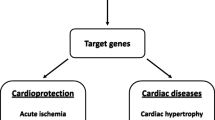Summary
Diseases accompanied by severe cardiac impairment like sepsis and chronic uremia are frequently linked to an increase in cytokine release. In order to investigate possible toxic effects of the immune mediators on myocardial cells, we studied the contractility of cardiac myocytes and the de novo formation of stress proteins in cultured heart cells under cytokine exposition. All cytokines investigated induce, concentration-dependently, arrhythmias and cessation of spontaneous contractions. Interleukin(IL)-2, IL-3, IL-6, and tumor necrosis factor (TNF) stimulate the synthesis of a 30 kD stress protein in heart cells, whereas IL-1 additionally evokes two proteins of the 70 kD family. These findings confirm a direct interference of the interleukins and TNF with myocytes and, especially, myocardial protein formation. As the induction of stress proteins makes cells more resistant towards a subsequent challenge, the cytokines are possibly involved in the activation of cell protecting mechanisms in cardiac myocytes.
Similar content being viewed by others
References
Dinarello CA, Cannon JG, Wolff SM, Bernheim HA, Bentler B, Cerami A, Figari IS, Palladino MA, O'Connor JV (1986) Tumor necrosis factor (cachectin) is an endogenous pyrogen and induces production of interleukin 1. J Exp Med 163:1433–1450
Drüeke T, LePailleur C, Sigal-Saglier M, Zingraff J, Crosnier J, DiMatteo J (1981) Left ventricular function in hemodialyzed patients with cardiomegaly. Nephron 28:80–87
Editorial (1991) Stress proteins and myocardial protection. Lancet 337:271–272
Engelhardt R, Mackensen A, Galanos C, Andreesen R (1990) Biological response to intravenously administered endotoxin in patients with advanced cancer. J Biol Response Mod 9:480–491
Gulick T, Chung MK, Pieper SJ, Lange LG, Schreiner GF (1989) Interleukin 1 and tumor necrosis factor inhibit cardiac myocyte β-adrenergic responsiveness. Proc Natl Acad Sci USA 86:6753–6757
Herbelin A, Nguyen AT, Zingraff J, Urena P, Descamps-Latscha B (1990) Influence of uremia and hemodialysis on circulating interleukin-1 and tumor necrosis factor alpha. Kidney Int 37:116–125
Hülsmann WC, Dubelaar ML (1988) Effects of tumor necrosis factor (TNF) on lipolytic activities of rat heart. Mol Cell Biochem 79:147–151
Ispahani P, Pearson NJ, Greenwood D (1987) An analysis of community- and hospital-acquired bacteraemia in a large teaching hospital in the United Kingdom. Quart J Med 63:427–440
Lee RE, Lotze MT, Skibber JM, Tucker E, Bonow RO, Ognibene FP, Carrasquillo JA, Shelhamer JH, Parrillo JE, Rosenberg SA (1989) Cardiorespiratory effects of immunotherapy with interleukin-2. J Clin Oncol 7:7–20
Löw I, Friedrich T, Schoeppe W (1989) Synthesis of shock proteins in cultured fetal mouse myocytes. Exp Cell Res 181:451–459
LÖw-Friedrich I, Schoeppe W (1991) Effects of calcium channel blockers on stress protein synthesis in cardiac myocytes. J Cardiovasc Pharmacol 17(5):800–806
Lonnemann G, Koch KM, Shaldon S, Dinarello CA (1988) Studies on the ability of hemodialysis membranes to induce, bind, and clear human interleukin-1. J Lab Clin Med 112:76–86
Natanson C, Mitchell P, Ballantyne HK, MacVittie TJ, Conklin JJ, Parrillo JE (1986) Gramnegative bacteremia produces both severe systolic and diastolic cardiac dysfunction in a canine model that simulates human septic shock. J Clin Invest 78:259–270
Nisbeth U, Hallgren R, Eriksson O, Danielson BG (1987) Endotoxemia in chronic renal failure. Nephron 45:93–97
O'Farrell PZ, Gold LM (1973) Bacteriophage T4 gene expression. J Biol Chem 248:5502–5511
Ognibene FP, Parker MM, Natanson C, Shelhamer JH, Parrillo JE (1988) Depressed left ventricular performance. Response to volume infusion in patients with sepsis and septic shock. Chest 93:903–910
Parrillo JE (1989) The cardiovascular pathophysiology of sepsis. Ann Rev Med 40:469–485
Polla BS (1988) A role for heat shock proteins in inflammation. Immunol Today 9:134–137
Reithmann C, Gierschik P, Werdan K, Jakobs KH (1991) Tumor necrosis factor α up-regulates Giα und Gβ proteins and adenylyl cyclase responsiveness in rat cardiomyocytes. Eur J Pharmacol 206:53–60
Riehle M, Bereiter-Hahn J (1991) Amplitude and frequency determination of cardiomyocyte contractions in culture by means of digital image analysis. Eur J Cell Biol 54 (Suppl 32):81
Rosenberg SA, Lotze MT, Yang JC, Aebersold PM, Linehan WM, Seipp CA, White DE (1989) Experience with the use of high-dose interleukin-2 in the treatment of 652 cancer patients. Ann Surg 210:474–485
Schlage WK, Bereiter-Hahn J (1983) A microscope perfusion respirometer for continuous respiration measurement of cultured cells during microscopic observation. Microscopica Acta 87(1):19–34
Schlesinger MJ, Tissières A, Ashburner M (1982) Heat shock proteins: from bacteria to man. Cold Spring Harbor Laboratory, Cold Spring Harbor, New York, pp 440
Schlesinger MJ (1986) Heat shock proteins: The search for functions. J Cell Biol 103:321–325
Schlesinger MJ (1990) Heat shock proteins. J Biol Chem 265:12111–12114
Spitz DR, Dewey WC, Li GC (1987) Hydrogen peroxide or heat shock induces resistance to hydrogen peroxide in chinese hamster fibroblasts. J Cell Physiol 131:364–373
Tissières A, Mitchell HK, Tracy VM (1974) Protein synthesis in salivary glands of Drosophila melanogaster: relation to chromosome puffs. J Mol Biol 84:389–398
Wagenknecht B, Hug M, Hübner G, Werdan K (1989) Myokardiale Wirkungen von Mediatoren. Intensivmed 26 (Suppl 1):32–40
Wessel D, Flügge UI (1984) A method for the quantitative recovery of protein in dilute solution in the presence of detergents and lipids. Analyt Biochem 138:141–143
Wolffe AP, Glover JF, Tata JR (1984) Culture shock. Exp Cell Res 154:581–590
Author information
Authors and Affiliations
Rights and permissions
About this article
Cite this article
Löw-Friedrich, I., Weisensee, D., Mitrou, P. et al. Cytokines induce stress protein formation in cultured cardiac myocytes. Basic Res Cardiol 87, 12–18 (1992). https://doi.org/10.1007/BF00795385
Received:
Accepted:
Issue Date:
DOI: https://doi.org/10.1007/BF00795385




